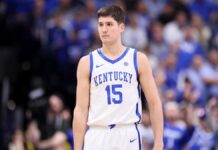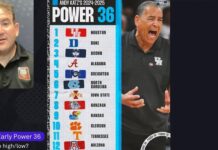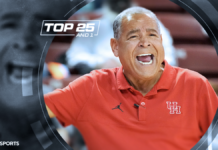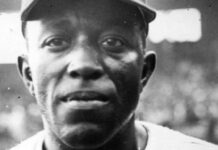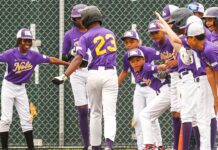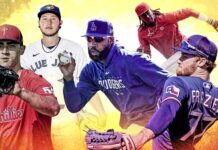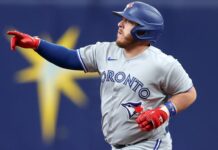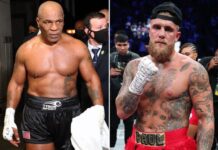Over the last two weeks, we’ve been updating Top 30 Prospects lists for every organization. We’ve ranked, graded and reported on 900 rising talents who hope to make an impact in the Majors.
And yet it’s never enough. Going 30 deep still doesn’t give us enough space to include every intriguing phenom or future big leaguer. Whether it’s a farm system stocked with plenty of talent or one that’s thin in the Minors, it’s always a tough call deciding who grabs the last spots on a Top 30 and who gets left out.
Below, we identify the prospect who came closest to making each team’s Top 30 but fell just short. When we looked at Prospects No. 31 a year ago, five of them would go on to appear in the Majors in 2020: Tigers infielder Sergio Alcantara, Brewers right-hander Phil Bickford, Red Sox left-hander Kyle Hart, Twins lefty Devin Smeltzer and Blue Jays righty T.J. Zeuch.
Blue Jays: Chavez Young, OF
The Bahamas native was selected in the 39th round of the 2016 Draft out of a Georgia high school, and it’s a testament to what he’s shown so far that he’s even on the Top 30 bubble. Young is an above-average runner who stole 44 bags in 2018 and features plenty of arm strength to provide defensive value in center. He can be a bit Dr. Jekyll and Mr. Hyde as a switch-hitter: more contact from the left, more power from the right. Even developing into an average hitter would brighten Young’s profile and help get him north of the border.
Orioles: Darell Hernaiz, SS
The Orioles drafted Hernaiz in the fifth round of the 2019 Draft out of the Texas high school ranks and watched him have a solid pro debut in the Gulf Coast League that summer. He showed off an advanced approach at the plate with excellent on-base skills and he could grow into some more power as he matures. Defensively, he has the actions and enough arm to stay at shortstop.
Rays: Pedro Martinez, INF
Martinez was picked up from the Cubs last September as a player to be named later in the deal that sent Jose Martinez the other way. He would comfortably fit in any other farm system’s Top 30 but only finds himself on the outside looking in because of Tampa Bay’s depth. The switch-hitting Venezuela native receives above-average grades for his hit, run and arm tools, and he should be a possibility at shortstop, second or third going forward. Martinez will be only 20 in 2021 and has plenty of time to make an impression on his new organization.
Red Sox: Frank German, RHP
The highest-drafted pitcher in North Florida history, German went to the Yankees in the fourth round of the 2018 Draft and joined the Red Sox in the Adam Ottavino trade in January. He may be more reliever than starter, but he has a mid-90s fastball that reaches 98 mph and a solid changeup with fade and sink.
Yankees: Oswaldo Cabrera, INF
Cabrera doesn’t have loud tools, but he’s a switch-hitter who makes a lot of line-drive contract and can provide steady defense at a number of positions. Signed for $100,000 out of Venezuela in 2015, he held his own as a 20-year-old playing every day in High-A at age 20 in 2019.
Indians: Milan Tolentino, SS
The son of former big leaguer and current Angels broadcaster Jose Tolentino, Milan was one of the best defensive shortstops in the 2020 Draft. Signed for an over-slot $800,000 in the fourth round out of a California high school, he has plus arm strength and range, a high baseball IQ and a knack for making opposite-field contact.
Royals: Sebastian Rivero, C
The Royals’ decision to protect Rivero from the Rule 5 Draft by giving him a spot on the 40-man roster last November spoke volumes about the organization’s evaluation of him. Since signing out of Venezuela in July 2015, Rivero has developed a reputation as a strong defensive catcher with good receiving and blocking skills and a solid arm. The bat is a major drag on the rest of the profile, but the bar isn’t as high there for catchers. If he can manage to even be a 45-grade hitter at the top level, Rivero will do enough to carve out a role as a backup backstop.
Tigers: Alex Lange, RHP
Acquired from the Cubs at the 2019 Trade Deadline for Nick Castellanos, Lange has showed positive signs of regaining the form that made him a first-rounder out of LSU four years ago. The right-hander has touched as high as 97.7 mph on the radar gun this spring and now sits more comfortably in the mid-90s than previously. He pairs a good curveball with a developing slider and also sports a change. Control issues and a high-effort delivery mean the 25-year-old right-hander is likely going to stick in a bullpen role, but he shouldn’t be far off from helping Detroit in that way. He just needs to locate better.
Twins: Dakota Chalmers, RHP
The Twins acquired Chalmers from the A’s while he was rehabbing from Tommy John surgery and he pitched well enough upon his return, especially in the Arizona Fall League, to get added to the 40-man roster. He has elite-level spin rates on his plus curve and a fastball that gets up to 98 mph. Command is still an issue, so the best chance for Chalmers is likely to use that fastball-breaking ball combination coming out of a bullpen.
White Sox: Kade McClure, RHP
A sixth-round pick from Louisville in 2017, McClure missed much of his first full pro season with a knee injury and showed pedestrian stuff in his second. But at instructional league last fall, he opened eyes by adding about 3 mph of velocity working in shorter stints and looking like a useful multi-inning reliever with a 92-95 mph fastball and an effective slider.
Angels: Adam Seminaris, LHP
Seminaris was the Angels’ fifth-rounder in the 2020 Draft out of Long Beach State. He very much fits the “advanced college lefty” label, one with largely average stuff across the board, but with a good idea of what to do with it. It’s a legitimate four-pitch mix, with a changeup that flashes plus his best offering. Deception and command help all of the stuff play up to give him the chance to be a back-end starter.
Astros: Scott Manea, C
The Mets signed Manea as a nondrafted free agent out of St. Petersburg (Fla.) in 2016 and included him in the J.D. Davis trade three years later. He has simplified his swing since changing organizations and could become a big league backup with his right-handed power and attractive framing metrics.
A’s: Drew Millas, C
Taken in the seventh round of the 2019 Draft out of Missouri State, Millas stands out for his work behind the plate. He’s super-athletic and runs very well, with that agility showing up in his blocking and receiving while his plus arm can help control the running game. There are more questions about the bat, but his defense alone gives him the chance to be a solid big league backup.
Mariners: Tyler Keenan, 3B
Keenan’s power bat stood out at Mississippi, helping him lead the team in homers as a sophomore and hit seven out in 17 games before the shutdown in 2020. That led to the Mariners taking the left-handed hitter in the fourth round in the hopes that power will play, though there are some concerns about his swing working at this level. He does manage the strike zone well to help him get to that power, which will be important since some see a future move to first base.
Rangers: Demarcus Evans, RHP
One of the more dominant relief prospects in the game, Evans led all Minor League relievers in strikeout rate (16.6 per nine innings) in 2018 and in opponent average (.119) while ranking third in ERA (0.90) in 2019. A 25th-rounder from a Mississippi high school in 2015, he thrives thanks to an explosive 93-96 mph fastball with high spin rates, unusual vertical movement and the extension in his delivery.
Braves: Philip Pfeifer, LHP
At age 28, he’s getting a little old for prospect lists, but it’s hard to look past his stuff and his left-handedness. He looked destined for a life in a bullpen but a move to the rotation in 2019 worked well, better command, potentially raising his ceiling. It’s still more likely, though, that his plus curve with high spin rate and his low-90s fastball could be very effective in shorter stints.
Marlins: Jorge Guzman, RHP
Originally signed by the Astros for $22,500 out of the Dominican Republic in 2014, Guzman has been included in trade packages for Brian McCann (November 2016) and Giancarlo Stanton (December 2017). He can work at 95-98 mph for several innings and has pushed his fastball to 103 mph, though he lacks consistency with his secondary pitches and especially his control and command.
Mets: Jake Mangum, OF
The 2019 fourth-rounder is an above-average runner, and he combines that speed with a 55-grade arm to play all three outfield positions well. The run, fielding and arm tools are the main pillars of the profile, and he’ll need them to be above-average if he is going to climb toward Queens. The switch-hitter doesn’t hit for any power due to a batted-ball profile that keeps things on the ground, and that drags down his offensive ceiling, even after he hit .357 over four seasons at Mississippi State. Mangum is now 25 and needs to start hitting quick upon the resumption of Minor League play.
Nationals: Todd Peterson, RHP
The Nats have three big right-handers at the top of the system in Cade Cavalli, Jackson Rutledge and Cole Henry and another could join them in the top 30 soon. Peterson, a seventh-round pick out of LSU in 2019, can touch 98 with his fastball and features an above-average slider. He worked primarily as a reliever in college, but Washington is still figuring out whether he could be at least a piggyback starter in the pros. If he can eat multiple innings with his two promising pitches, he’ll find some role in the capital.
Phillies: C.J. Chatham, INF
A second-round pick of the Red Sox in 2016, Chatham was sent to the Phillies in a minor deal in January. He has a knack for contact, without much power, and has enough range and arm to play shortstop. His ceiling is somewhat limited, but he does have a fairly high floor as a utility type who can play all over the infield.
Brewers: Tyrone Taylor, OF
Taylor has already featured in 37 Major League games, so Brewers fans have some idea of what he can do. The 2012 second-rounder features above-average speed and can be a solid defender from all three outfield spots. The late-game defensive replacement has been his primary role to this point, but he’s capable of showing some flashes with the bat too, as he did in 2020 when six of his nine hits went for extra bases. The power is still likely to be below-average at the top level. Taylor turned 27 in January, so he is who he is at this point – a player in his prime still fighting for a reserve outfield spot.
Cardinals: Griffin Roberts, RHP
Roberts throws a mid-80s slider that features a ton of spin from a three-quarters arm slot, and that pitch alone makes him an intriguing prospect. He has sat in the mid-90s previously with the fastball, but it was closer to the low 90s last year. The 2018 43rd overall pick saw his stock tumble when he posted a 6.44 ERA in 65 2/3 innings at Class A Advanced Palm Beach in 2019, and the lost 2020 campaign robbed him of a chance to bounce back. When he does return to competitive play, he’ll need to show much better command and control of all three pitches. At least, the heater and slider should give him a chance in relief at some point.
Cubs: Justin Steele, LHP
The Cubs gave seven-figure bonuses to three high school pitchers in the middle rounds of the Draft, and Steele ($1 million in the fifth round as a Mississippi high schooler) is the only one still in the organization. Slowed by Tommy John surgery in 2017, he’s on the verge of making the big leagues with a four-seam fastball that ranges from 92-97 mph and a mid-80s slider that some club officials believe is the best in the system.
Pirates: Rodolfo Nolasco, OF
Nolasco was part of the Pirates’ haul in the 2018-19 international signing period who then helped their second of two Dominican Summer League teams set the world on fire in 2019. Nolasco hit .302/.373/.472 during that debut with an offensive profile — there’s bat speed and power aplenty here — that should fit well in right field.
Reds: Luis Mey, RHP
Don’t pay any attention to the numbers Mey posted in his pro debut in the Rookie-level Arizona League in 2019 as they are not indicative of his stuff. The right-hander, who doesn’t turn 20 until late June, has a fastball that can sit in the mid-90s and touch higher than that to go along with a solid slider. He needs to work on his secondary stuff and his command, but he’s athletic and can repeat his delivery with his projectable 6-foot-2 frame, giving him the chance to be a good strike-thrower in the future.
D-backs: Humberto Mejia, RHP
The Marlins were pleased enough with Mejia’s progress that they gave him three Major League starts in 2020, despite the fact he hadn’t pitched above Class A Advanced yet. They then moved him to Arizona at the deadline in a deal for Starling Marte. Mejia showed 50-grade velocity with a 92.8 mph average fastball in the Majors last year, but his above-average curve is his best pitch. He also flashed a slider and changeup. It’s a starter’s arsenal, albeit one without a true plus pitch. Mejia should be a depth starting option for the D-backs this summer.
Dodgers: Nick Robertson, RHP
Robertson has transformed his body and his stuff significantly since the Dodgers took him in the seventh round of the 2019 Draft out of James Madison. He was a revelation in instructional league, where he excelled with an invisible 93-96 mph fastball and power curveball, and he could make the jump from Rookie ball in 2019 to the big leagues this year.
Giants: Sean Roby, 3B
Roby slugged his away into the 12th round of the 2018 Draft by finishing fourth among national junior college hitters with 22 homers. The Arizona Western JC product has plus raw power, solid arm strength and has drawn some David Freese comparisons.
Padres: Carlos Guarate, RHP
The 19-year-old right-hander could have moved into the Top 30 if he had a normal 2020. He certainly had plenty of momentum coming off a 2019 in which he jumped stateside and made a Class A cameo in his age-18 season. Guarate’s best pitch is a curveball that features good depth and movement, and he was sitting in the low 90s with his fastball. There is some projection in his 6-foot-2 frame as well, and that could mean more velocity will come. The more Guarate can show off his stuff at full-season levels, the more possibilities he has to climb the San Diego list.
Rockies: Dom Nuñez, C
Nuñez began his pro career as an infielder but quickly moved behind the plate after his debut summer. He’s build a reputation as a solid and athletic receiver, one who has thrown out 32 percent of potential basestealers in the Minors. The bat has been behind, but he started to show more power at the upper levels of the system, leading to his big league debut in 2020 and he’s penciled in as the backup in Colorado this year.





















